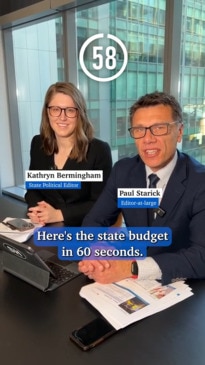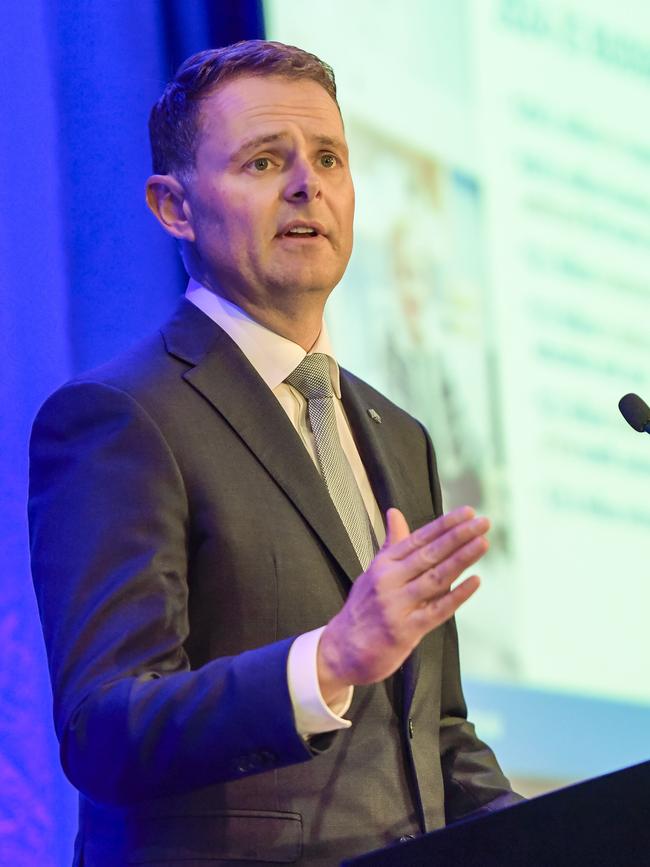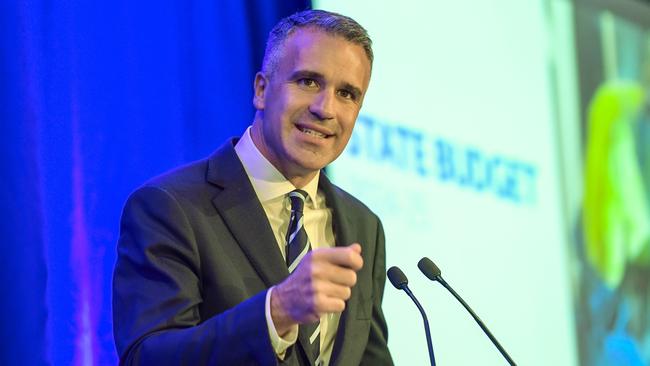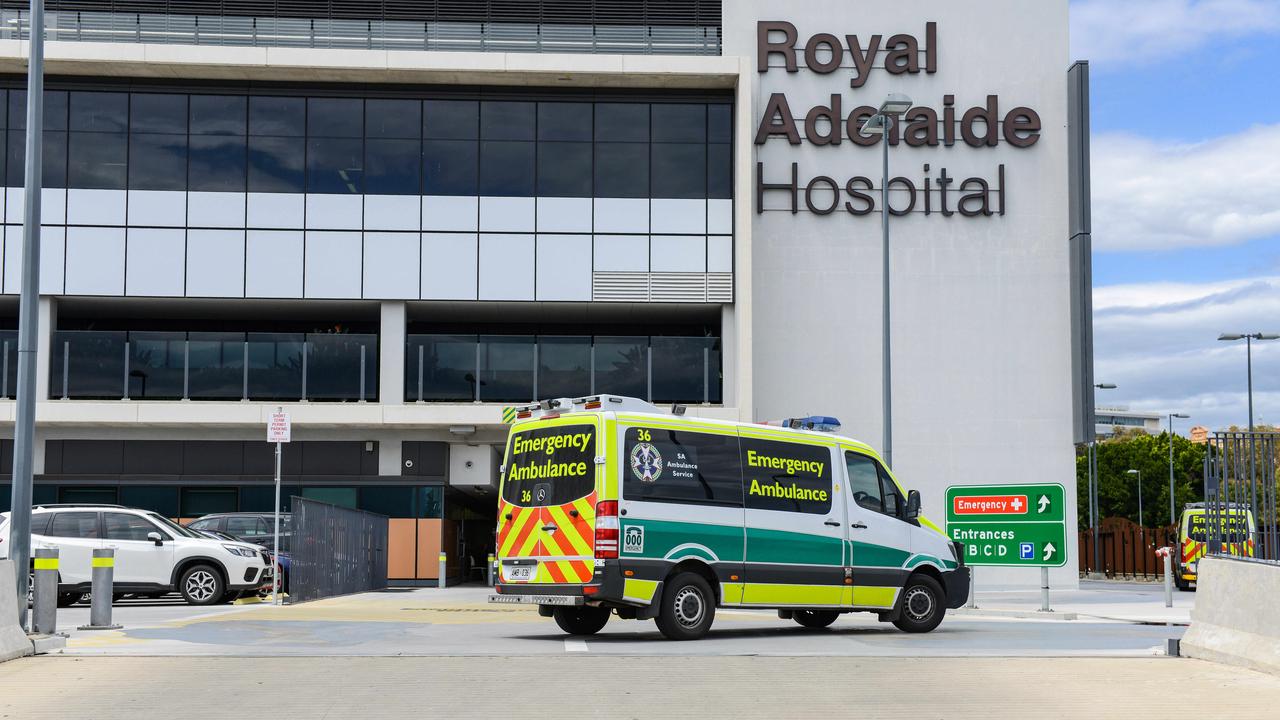Labor puts cost-of-living at heart of budget as state debt set to grow by 50pc
Cash-strapped South Aussie families will benefit from new budget money within weeks but it’s going to come at a long-term cost to the state.

SA News
Don't miss out on the headlines from SA News. Followed categories will be added to My News.
South Australia will take on billions of dollars of extra debt to fund record health and infrastructure spending in the state budget – and more than 210,000 households are set to receive near-immediate cost-of-living relief.
Debt will balloon to $44.2bn by mid-2028, with the state government credit card to pay for the $15.4bn Torrens to Darlington project and the $3.2bn new Women’s and Children’s Hospital.
The opposition says delays to the two projects have “unleashed a debt bomb on future generations of South Australians”, with debt “almost guaranteed to pass $50bn beyond the forward estimates”.
The government, which says South Australia is well-positioned to service the growing debt, will look to win over the public with up to $600 in extra cost-of-living relief for a family with two school-aged children.

Under a $266.2m relief package – identified by Treasurer Stephen Mullighan as a cornerstone of the budget – the school sports vouchers program will be expanded to cover music lessons and doubled in value to two $100 vouchers per child per year.
A one-off extra Cost of Living payment of $243.90 will be paid this month to upwards of 210,000 concession holders who received the payment last year, while tenants and seniors card holders will permanently have their payments doubled from $122 to match the $243.90.
There will also be a $200 reduction in the school materials and services charge for eligible families in the 2025 school year.
“This year’s budget puts more money in the pockets of those doing it toughest,” Mr Mullighan said in his budget speech to parliament on Thursday.
The government is projecting budget surpluses out to mid-2028, including this year and last year. But the record funding will come at a cost – with the state’s actual net debt figure to continue to grow.
Debt will balloon from an estimated $27.9bn at the end of this financial year to $44.2bn by mid-2028, which Treasurer Mr Mullighan said would ensure the state has “capacity to invest in the infrastructure needs of our community”.
Other State Budget measures include:
- A RECORD $2.5bn in extra funding for the ailing health system, bringing Labor’s total extra investment to $7.1bn over the past three budgets
- STAMP duty abolished for all first homebuyers who build or buy brand new homes, and first home owners grant eligibility expanded
- ANOTHER $715m over five years to implement early childhood education measures, including $339.7m for universal 3-year-old preschool and $127.3m for more preschool hours to support children most in need
- A $692.6m increase in skills funding over the next five years to train South Australians for the jobs of the future, delivering more than 160,000 training places
- $13.7m OVER three years to improve waterbird habitat at the Lake Hawdon North wetland site, near Robe in the South East
- CONSTRUCTION of more than 1900 homes at Seaton and Noarlunga Downs at a cost of $576m
- $20.8m TO increase marketing of South Australia both interstate and overseas, and $14m over four years to expand the Business Events Fund to boost visitation in winter months
- AN investment of $218m to build a new preschool and primary school in Mount Barker and a new high school in Adelaide’s northern suburbs
- MORE than $200m to build more than 350 extra bed’s in South Australia’s prison system
- $20m FOR small business energy grants
- $8.3m OVER four years to ensure the Tour Down Under continues as a world-class event
Responding to the state budget, ratings agency S&P said South Australia can take on more debt because of a likely increase in tax revenue driven by a strong property sector and historically tight labour market.
Tax revenues have been revised up by $357m for 2023-24 and by a further $1bn over the period from 2024-25 to 2026-27 due to increased collections from payroll tax, conveyance duty and land taxes.
Stronger national GST collections this year and changes to South Australia’s share of the tax have pushed up revenues by $162m in 2023-24 and by a forecast $635m between 2024-25 and 2026-27.
“While the government has benefited from strong revenue collections from robust economic performance, those revenues ave allowed us to get the budget back into surplus, reduce taxes, increase funding in key areas and invest in more infrastructure,” Mr Mullighan said.
South Australian Business Chamber chief executive Andrew Kay said the budget failed to address the pressing needs of the business community.
“This was an opportunity for the Malinauskas government to initiate genuine payroll tax reform, given this year’s surplus and the projected surplus in the years ahead fuelled by taxation revenue,” he said.
Opposition treasury spokesman Matt Cowdrey said the cost-of-living relief included in the budget was “a drop in the ocean” and could have been better targeted.
He said South Australians should be concerned that the government is saddling the state with increasing debt.
“After three budgets, South Australians must ask the question – am I better off under Labor? The answer is a resounding no,” he said.

Another $16 billion added to South Australia’s state debt
By Cameron England
Government debt will blow out by more than 50 per cent over the next four years as the cost of the state’s major infrastructure builds makes its impact felt.
Treasurer Stephen Mullighan is projecting six consecutive budget surpluses in a row out to mid-2028, including this year and last, but the state’s actual net debt figure will continue to worsen for the next three years beyond the government’s own previous forecasts.
This will add another $1.9bn to South Australia’s debt burden.
And this does not count the final year in the government’s forward projections, when the level of non-financial public service net debt – the preferred measure of a state government’s debt burden – increases from an estimated $27.9bn at the end of this financial year to $44.2bn in mid-2028.
Mr Mullighan was keen to emphasise however, that the government’s net debt ratio – its debt to revenue figure – improves marginally against previous estimates over the next two years, and is virtually the same as the previous estimate out to 2026-27.
At the end of that financial year, the ratio is estimated to hit 122.2 per cent, up from the previous forecast of 121.6, before blowing out to 131.8 per cent in 2027-28. This compares with an estimated ratio of 96.8 per cent at the end of this financial year.
Mr Mullighan said in his Budget speech that at the end of the current financial year, net debt was projected to be $3.6bn lower “than what had been forecast by the previous government, and the key debt affordability metric, the net debt to revenue ratio, is more than 28 percentage points lower than what had been forecast’’.
“As a result of the Budget’s record $25.6bn infrastructure program, non-financial public sector net debt is forecast to increase by $16.3bn over the forward estimates, reaching $44.2bn as at 30 June 2028, however with a net debt to revenue ratio of 131.8 per cent, only 2.2 percentage points higher than what had been forecast by the previous government,’’ he said.
Mr Mullighan was at pains to talk up the strength of the state economy in delivering his third state Budget, pointing out that South Australia has recorded the best economic growth rate of all states in two of the last three years.
“Our exports have reached record levels and our tourism figures show more and more visitors are choosing our state as a destination, and many of them are coming with capital to invest,’’ Mr Mullighan said in his Budget speech.
“Our state’s strong economy has seen state taxation revenue revised up by $357m in 2023-24 since the mid-year budget review and by a further $1.1bn over the period 2024-25 to 2026-27, mainly due to higher forecast collections from payroll tax, conveyance duty and land taxes.
“Further, stronger national GST collections in 2023-24 and changes to South Australia’s share of GST revenue since the mid-year Budget review means GST grant revenues have been revised up by $162m in 2023-24 and by $635m over the period 2024-25 to 2026-27.
“While the government has benefited from strong revenue collections from robust economic performance, those revenues have allowed us to get the Budget back into surplus, reduce taxes, increase funding in key areas, and invest in more infrastructure.’’
Mr Mullighan said the forecast surpluses “are important to provide a buffer in case of lower economic growth or to provide greater support to the community’’.
The surplus is forecast to come in at $306m this financial year, $248m next year and is expected to more than double from that figure by 2026-27 to $568m.
On the economic growth front, state final demand is expected to stay weak, coming in at 1.5 per cent next financial year before increasing to 2 per cent in 2026-27.
Employment growth is expected to tail off precipitously from 2 per cent this year to just half a per cent next financial year, with Mr Mullighan saying this came after two years of strong employment growth.
“Our unemployment rate has fallen to a record low of 3.3 per cent, and even as it moderates we still record the highest number of job vacancies in the state’s history,’’ Mr Mullighan said.
The state’s economy grew by 4.7 per cent in 2020-21 and 5.1 per cent the following year, however both of these periods were significantly distorted by pandemic effects.

Treasurer’s silver lining in health budget
By Brad Crouch
Treasurer Stephen Mullighan buried his own gold nugget in this year’s state budget — a lucrative income stream not included in any revenue line.
Payroll tax hits many medical clinics from July 1, but while RevenueSA collects the money it will not appear on any bottom line until the following budget after officials work out how much they have collected.
Treasury officials say they cannot even make ballpark predictions to include in the forward estimates, as they do not have enough information on wages affected or exemptions for bulk billed consultations and need to wait until paperwork is reconciled.
The government stresses it is not a new tax but is a legal change in the existing law’s interpretation which now sees contractor GPs at clinics regarded as employees.
Treasurer Stephen Mullighan said “by and large” it should not add pressure on EDs, noting there is a $1.5m wages threshold and bulk billed consultations are exempt.
“The vast majority of GPs won’t be paying payroll tax under these measures,” he said.
Health spending will crack the $9bn mark for 2024-25, almost double the nearest portfolio of Education at $4.9bn and dwarfing the third biggest spender of Infrastructure and Transport at $1.9bn.
The spending comes as ambulance ramping hit a record 4773 hours in May and overwhelming demand on hospital EDs triggered cancellation of more than 500 elective surgeries in the past fortnight to free up ward beds.
The 2024-25 health budget of $9bn will rise by about $200m a year in the following three years.
The government has poured an extra $7.1bn into health over the past three budgets and it accounts for almost one-third of the entire state budget.
Mr Mullighan said: “This budget provides an additional $2.5bn in new measures to ensure South Australians continue to receive the very best health care.”
New health measures in this year’s budget include:
$30m over two years for an extra 56 new beds at the Queen Elizabeth and Lyell McEwin Hospitals;
$24m for new ambulance stations at Marion, Two Wells and Whyalla;
$23.5m over two years for the SA Ambulance Service to replace its paper records system used by paramedics with an electronic patient record system;
$10.7m over four years to double the size of the SAAS paramedic telehealth clinician team which helps direct emergency callers who do not need EDs to more appropriate care;
$17m over four years to expand renal haemodialysis in the northern metropolitan areas with an additional 21 chairs, supporting an extra 84 patients;
$15m over three yeas to manage a tuberculosis outbreak across the state;
$11.5m over four years for an upgrade of the Port Pirie Hospital ED;
$5m over four years to expand youth mental health services including an adolescent virtual urgent care service.
Health Minister Chris Picton said more than 330 new hospital beds would open by the end of next year.
“Already the Malinauskas government has added 1432 additional nurses, doctors, ambos and allied health workers above attrition to improve care for patients,” he said.





